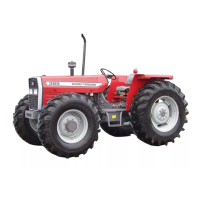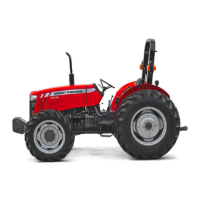C-2
Operating the
tractor
General operating safety
Before first time operation:
• Be sure to read all information in the Safety and Operation
sections before attempting to operate the tractor and
mower deck.
• Do not attempt to operate the tractor without first becoming
familiar with the location and function of ALL controls and
how to stop the unit. Thoroughly read the “Features and
controls” section.
• Drive in an open area without mowing to become
accustomed to the unit.
• Never allow passengers to ride on the unit.
• Before leaving the operator’s position for any reason, engage
the parking brake, disengage the PTO, stop the engine and
remove the key.
Operating on slopes can be dangerous
Never operate on slopes greater than 17.6 percent (10 degrees)
which is a rise of 3.5 feet (106 cm) vertically in 20 feet
(607 cm) horizontally.
Operate the unit at a slow ground speed when driving
onto slope.
When operating on slopes use wheel weights or
counterweights.
Use extra caution when operating on slopes with rear-mounted
grass catcher. Mow UP and DOWN the slope, never across the
face. Use caution when changing directions and DO NOT
START OR STOP ON SLOPE.
Checks before starting
• Check that crankcase is filled to full mark on dipstick. See
the engine manual for instructions and oil recommendations.
• Make sure all nuts, bolts, screws and pins are in place
and tight.
• Adjust the seat position, and make certain you can reach
all controls from operator’s position.
• Fill the fuel tank with fresh gasoline. Refer to engine m
for fuel recommendations.
• Make certain wheel weights are installed if you w
operating the unit on sloping ground.
Gasoline is highly flammable and must be
handled with care. Never fill the tank when the
engine is still hot from recent operation. Do not
allow open flame, smoking or matches in the area. Avoid
over-filling and wipe up any spills.
Starting the engine
1. While sitting in the operator’s seat, fully depress
the brake pedal (D) or set the parking brake (C).
2. Make sure that your feet are not depressing the ground
speed controls.
3. Disengage the PTO (B).
4. Set the throttle to the full position (H).
5. Pull the choke knob (J) out to choke the engine. (A warm
engine may not require choking.)
6. Insert the ignition key and turn it to the start position.
7. After the engine starts, move the engine throttle (H) control
to the slow position. Warm up the engine by running it
for at least a minute before engaging the PTO or driving
the tractor.
In the event of an emergency, the engine can be
stopped by simply turning the ignition switch to the
stop position. Use this method only in emergency
situations. For normal engine shut down, follow the
procedure given in “Stopping the tractor and engine”.
Stopping the tractor and engine
1. Stop tractor movement by releasing the ground speed
controls. For emergency stopping, depress the brake pedal.
2. Engage the parking brake (C).
3. Disengage the PTO (B).
4. Place the throttle control in the idle position (H).
5. Turn the ignition switch (E) to the stop position. Remove
the key.
Stopping the engine at speeds faster than
idle can cause engine damage.
Do not stop or park tractor over dry leaves,
grass or combustible materials.

